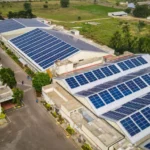India is steadily moving toward solar energy. The catch is that most families live in apartments or multi-unit blocks, which makes putting panels on the roof a bit of a puzzle. The good news is that clever new solar tools let these buildings share sunlight even when no single rooftop is fully private.
Anúncios
This guide speaks to Indian homeowners and housing societies. Inside, we line up the best options, rules, and gadgets that let neighbours pool solar power without owning grid space alone.
Why Solar Power Works for Indian Apartments?

Life in a crowded city flat is normal for most of us. Yet higher power bills, random outages, and climate worries push residents to hunt for smarter energy. Thanks to friendly policies and maturing tech, solar for apartments is both realistic and wallet-wise today.
Anúncios
Some good reasons to choose solar on the shared roof:
- Cheaper light for corridors, lifts, and pumps.
- Regular savings that show in every owner’s bill.
- Lower upkeep because the system sits in one place.
- A green badge that can lift resale value.
Top Solar Solutions for Apartments in India
- Group Net Metering (Shared Rooftop Solar) Group net metering lets one big panel setup on the common roof serve several flats at once. The solar output is split according to need, and the bills are sliced using easy energy credits.
- Supported now across Delhi, Gujarat, Karnataka and West Bengal.
- Best for: housing societies with unused terrace space.
- Virtual Net Metering
- Works when rooftop access is impossible.
- You fund a solar farm away from home.
- Your apartment gets credits for its share.
- No panels or wiring go on your roof.
- Best for: high-rises or rented flats.
- Balcony Solar Panels for Apartments
- These small kits plug into a normal socket.
- Brackets hold panels on the balcony rail.
- They run lights, fans and small gadgets.
- Setup is quick, costs very little.
- Limitations: not net metered, output is 200-500 W.
- SolShare Technology (New in 2025)
- SolShare links several flats to one solar array.
- Every apartment gets fair, metered power.
- No rooftop rights, rewiring, or extra meters.
- Pilot tests are underway; made for high-rises.
Government Support and Solar Policy in India
The Centre pushes rooftop solar for homes:
- PM Surya Ghar Yojana gives up to ₹78,000 in subsidy.
- State net metering lets groups and towers share power.
- Chandigarh demands solar on all housing societies.
- Smart Cities Mission backs panels on flats.
Keep these terms handy: Floor-level solar policies India, apartment solar subsidies, rooftop rules for 2025.
Also Read Top Solar-Powered Fans for Summer Cooling in India (2025)
Anúncios
Estimated Charges for Shared Solar Projects
| Set-Up Type | Scale | Estimated Charge | Plus Points |
|---|---|---|---|
| Balcony Solar | 250-500 W | ₹20,000-40,000 | Lower bill, no red tape |
| Group Net Metered Roof | 10-50 kW | ₹4-5.5 lakh per 10 kW | Flat-wide savings |
| SolShare Plant | 5-15 kW | ₹5-7 lakh | collected billing, fair share |
| Virtual Net Metered | 5-100 kW | ₹60,000-80,000 per kW | best for no-roof units |
Export to Sheets
Real Examples in Indian Cities
- Mumbai: 25 kW slab shrank block bills by 50%.
- Chandigarh: 300+ blocks went solar together.
- Kochi: panels run lifts and corridor bulbs.
- Delhi: RWAs snag rebates for rooftop schemes.
These wins prove apartment solar is working across India.
Challenges in Apartment Solar
- Getting owners on the same page.
- Clearing DISCOM and society nods.
- Crowded rooftops on tall towers.
- Lump-sum cash outlay upfront.
Start small or choose RESCO-pay-as-you-go for ease.
Benefits of Apartment Solar Installations
- Big dips in monthly power dues.
- Higher resale odds for units.
- Subsidies trim the final bill.
- Smaller carbon hit for the planet.
- Solar means lights, lifts, pumps run steady.
Related keywords: solar electricity for apartments, solar maintenance for buildings, solar billing in multi-unit homes.
FAQs-Solar for Apartments in India
Q1. Can an apartment building install rooftop solar?
Absolutely. A housing society can set up a shared panel system and settle credits via group net metering, or switch to virtual net metering if the roof layout won’t allow it.
Q2. Can renters benefit?
Definitely. Modern schemes like SolShare or virtual net metering let tenants tap solar power even when they do not own the rooftop.
Q3. What about maintenance?
Most installers offer annual maintenance contracts (AMCs), and the residents welfare association (RWA) or provider generally oversees upkeep of shared arrays.
Q4. Is there a subsidy?
Yes, both central and state rebates are offered under the PM Surya Ghar Yojana and various state rooftop solar programs.
Q5. What is the ROI?
Joint solar projects typically reach breakeven in four to five years, after which households enjoy almost two decades of free energy.
Q6. What if roof space is small?
Options include compact balcony kits, virtual solar models, or partnering with a nearby society and tapping SolShare links.
Final Thoughts: Get Your Apartment Solar-Ready by 2025
India is leaning hard on clean energy, and rooftop solar makes perfect sense in crowded cities such as Delhi, Mumbai, Hyderabad, and Chennai. Thanks to group metering, virtual net metering, and easy-to-install smart panels, even tall blocks of flats can trim their electricity costs.
Talk to your neighbours. Build a small solar committee. Call a trusted installer to check your rooftop and balcony options. Solar is no longer just for bungalows—it can power every Indian home.
Go solar, save money, and help the planet.










